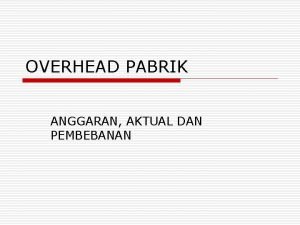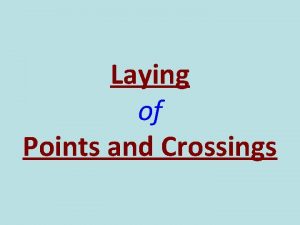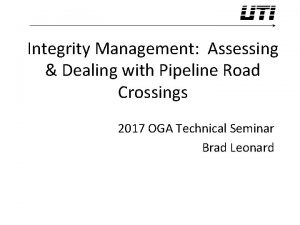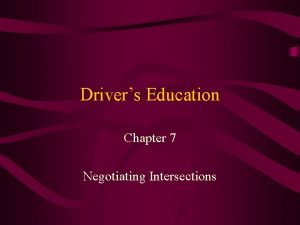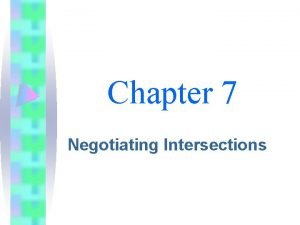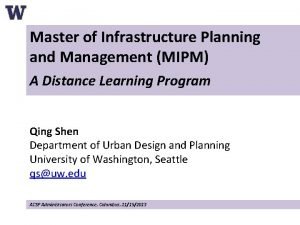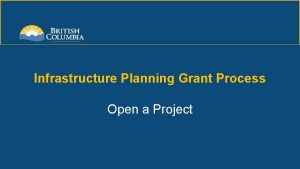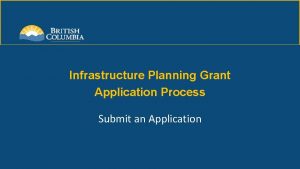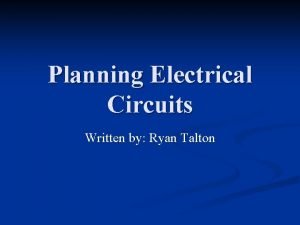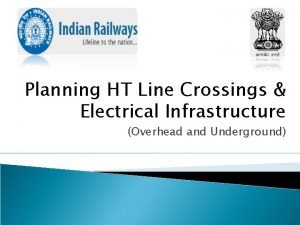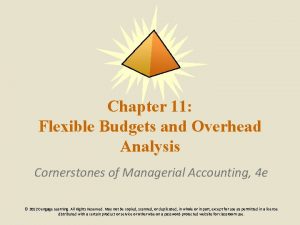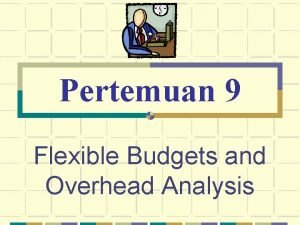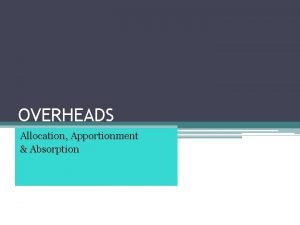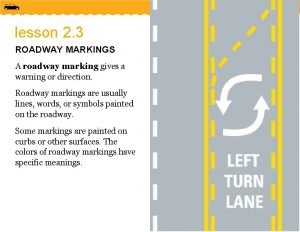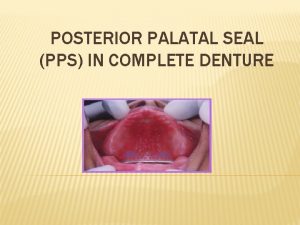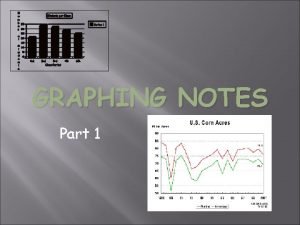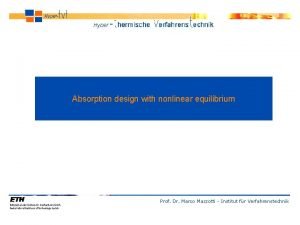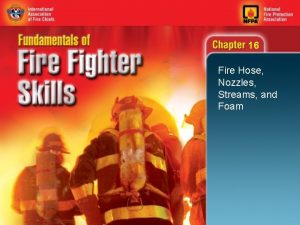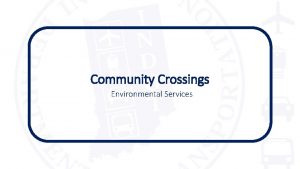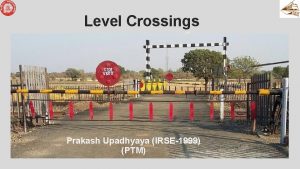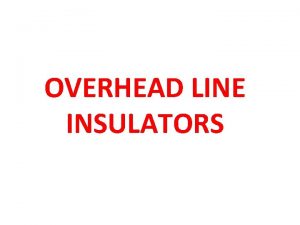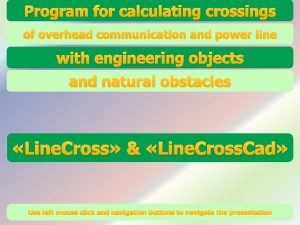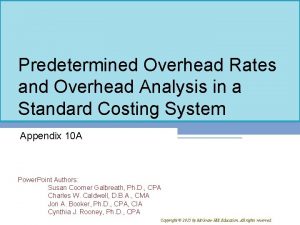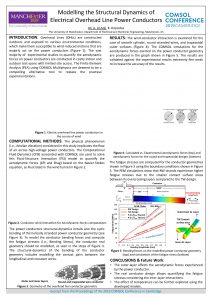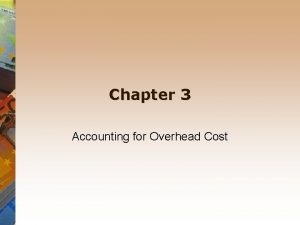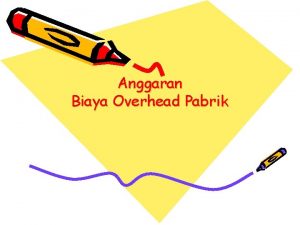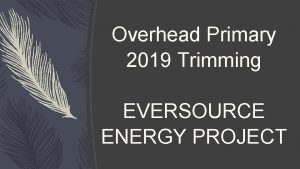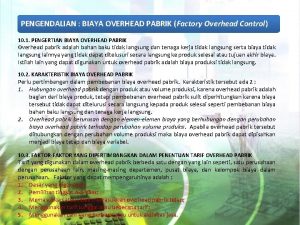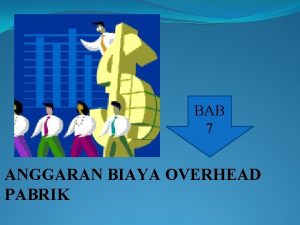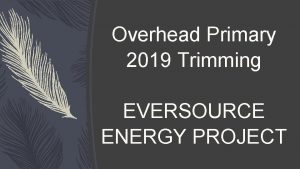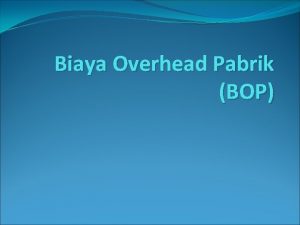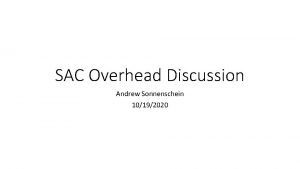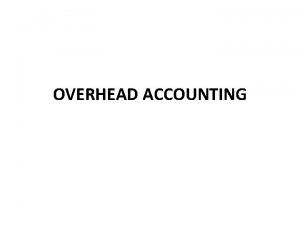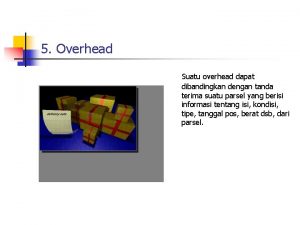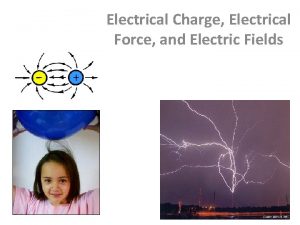Planning HT Line Crossings Electrical Infrastructure Overhead and





























- Slides: 29

Planning HT Line Crossings & Electrical Infrastructure (Overhead and Underground)

Introduction Ø Type of crossings- Overhead, Underground. Ø Upto & including 11 k. V – Underground cables. Above 11 k. V optional. Ø Regulations for Power line crossings of Railway tracks was issued by Railway Board in 1987 (A. C. Traction Manual Volume-II, Part-II, Appendix-IV). Ø The main issues covered in A. C. Traction Manual are as follows: Ø Scope- Crossings involving Railway tracks, Railway companies, Port Commissioner Railways, assisted & Private sidings. Ø The regulations do not apply to crossings of Railway tracks laid inside tunnels. Ø The regulations do not apply to Railway traction systems (1500 V DC & 25 k. V, 50 Hz AC, Single Phase) whose feeders/conductors/wires run along or across the tracks for traction purposes.

Cont… Ø Whenever new 25 k. V AC electrification is done & overhead crossing is already existing, the OHE should be designed to maintain requisite electrical clearance between top of OHE & bottom of transmission line conductor. Modification to transmission line should be the last resort. Ø Cases requiring approval by SEB (where crossing is already existing & track or railway electrification comes subsequently & crossing needs modification): - Ø Requisition by Railway to the owner of the crossing for modification in the overhead crossing. Ø Owner prepares an estimate of work for modification. Ø The estimate is then submitted by the nodal officer of railway (Sr. DEE/G) for Finance vetting. Ø After finance vetting, the estimated amount is submitted by the railway to the party. Ø After submission of fee, the owner (SEB) submits the proposal to the nodal officer (Sr. DEE/G) for approval of modified designs, calculations, drawings & method of execution of work for approval of concerned railway Deptt.

Cont… Ø Approval by Railway – Ø Required before commencing work. Owner shall submit designs, calculations, drawings & method of execution of work in Annexure -A. 4. 01. Ø The proposed has to comply with Indian Electricity Act, 1910; Indian Railways Act, 1890, IRSOD along with latest modifications & amendments. Ø The crossing should comply with requirements of communication lines of Indian Post & Telegraphs Deptt. The reference document is ‘Code of Practice for the Protection of Telecommunication lines at crossings with overhead power lines other than Electric Traction Circuits, issued by CEA, Telecommunication Directorate, Power & Telecommunication Coordination Committee. (PTCC unit), Govt. of India, New Delhi’. Ø Angle of Crossing - An overhead line crossing shall normally be at right angles to the Railway track. In special cases a deviation of upto 30 degree may be permitted.

Cont… Ø Structure – • Steel poles/masts fabricated steel structures or reinforced or pre-stressed concrete poles either of the self supporting or guyed type confirming in all respect to the Indian Electricity Rules, 1956 & complying with the latest codes of practice shall be used on either side of track to support the crossing span. • Wind loads as detailed in the latest edition of IS: 802 (Part 1)1977 shall be adopted. • Steel structures galvanized in accordance with IS: 2629 -1966. • Minimum Horizontal Distance of Structures: For New Structure H+6 For existing rigid well founded post/structures 3 m or 1. 5 m away from the toe of embankment/top of cutting, whichever is more Ref: ACS no. 20 to IRSOD 2004, dt. 17. 07. 17 • Factor of Safety - The factor of safety of all structures, conductors, guards, guys & ground wires used in crossing shall be as stipulated in the Indian Electricity Rules, 1956.

Cont… Ø Required Clearance between the overhead line & Railway track: SN Overhead crossing voltage Min. clearance from rail level Existing power line crossing for Non-Electrified Territory New Power line crossing or Crossing planned for alteration Min. clearance to be maintained between highest traction conductor & lowest transmission line crossing conductor At Mid Span 1 Upto & including 11 k. V Normally by Underground Cable 2 Above 11 k. V & upto 33 k. V 10860 14660 2440 3 Above 33 k. V & upto 66 k. V 11160 14960 2440 4 Above 66 k. V & upto 132 k. V 11760 15560 3050 5 Above 132 k. V & upto 220 k. V 12660 16460 4580 6 Above 220 k. V & upto 400 k. V 14460 18260 5490 7 Above 400 k. V & upto 500 k. V 15360 19160 7940 8 Above 500 k. V & upto 800 k. V 18060 21860 7940 Ref: ACS 20 of IRSOD dt. 17. 07. 17

Cont… Ø If the crossing is provided with a guarding, a minimum clearance of 2000 mm is required between bottom of the guard wire & highest traction conductor. Guarding is must for voltages upto 33 k. V. For voltages in the range (33 k. V – 220 k. V), total tripping time ≤ 200 msec & for voltages > 220 k. V, total tripping time ≤ 100 msec. Ø Power line crossings in yards & station area shall be avoided. Ø Insulators – In crossing spans double set of strain insulator strings shall be used. Each string of such strain insulators shall have one insulator more than used in normal span. The factor of safety of each string of insulators under the worst conditions shall not be less than 2. Ø Anti-Climbing Devices to be provided where voltage > 650 Volts. Ø Protection from moving road vehicles – wherever required, provide guard rails suitably painted. Ø Earthing– Each structure on either side of the crossing span supporting the transmission/distribution line conductors shall be earthed effectively by two separate and distinct earths and connections.

Cont… Ø Wherever Earth resistance of independent tower/structure> 10 ohms, provide multiple earth electrodes, or suitable treat the soil surrounding the earth electrode. Ø The cross section of earth conductor should be chosen so that it is not damaged while carrying short circuit current. Ø Type of Cables – The owner shall specify & obtain prior approval of the Railway for the type of cable he/she intends to use for crossing. Preferably armoured. Ø The armour & sheathing of cables to be earthed at both ends. The scheme & method of earthing shall specifically be approved by the Railway. Ø Use of cast iron or spun concrete pipe for laying of cable is obligatory. Specification of the Pipes to be used for cable laying to be approved from the Railway. Ø It should be possible to withdraw the cables for repairs or replacement without disturbing the track or formation.

Cont… Ø Ø Pipes shall be laid with gradient to facilitate drainage of water. Online application has to be filed by the Party. Pipes shall be laid with gradient to facilitate drainage of water. After approval from Railway, agreement as per Annexure-A 4. 02. Same have been incorporated in the draft agreement placed on http: //ircep. gov. in/WLRMS.

Procedure for online Application Practices followed earlier by Railways ◦ Earlier Off-line system was being followed for granting of permission to overhead & underground power line crossings. ◦ Party needed to submit application to concerned Divisional office along with the required documents. ◦ In absence of any specific timelines & amount for the work, the time for granting of work varied from 3 months to upto taking more than a year. ◦ The charges varied from Railway to Railway.

Procedure for online Application For system transparency & streamlining the process for granting permission to overhead and underground power line crossings through the Railway tracks, a Joint Procedure Order (JPO) was issued with the approval of Railway Board (MTR, ME, MT & FC) on 30. 01. 17. Way Leave Charges – Sr. DEN© after having received the application from Sr. DEE/G will make the estimate for way leave charges as per the Board’s guidelines, which were issued vide letter no. 2013/LML 1/24/41 dt. 30. 07. 14. According to this for electrical crossings, if the owner is Govt. agency (Central or State), one time recovery of Rs. 12, 800/- shall be made by Railway with way leave agreement for 35 years which can be further renewed for another 35 years. Railway has further developed an online portal for registration and tracking of application. http: //www. ircep. gov. in/WLRMS. Status of application can be tracked. As per the JPO, One hour block per year shall be granted (without levy of charges) for regular maintenance of crossings. Regular meeting on monthly basis to be held with the Nodal Officer (Sr. DEE/G of Division).

Procedure for online Application • Select the link for Online application

Fill in the details for transmission line crossing

Cont… Main points in Annexure A 4 -02 (Agreement for over head crossing) Ø Drawing approved by the Railway. Ø All repairs to be executed from time to time in accordance with approved drawing & to the satisfaction of the Railway. Cost, if any, to be borne by the owner. Ø Owner, his/her employees can not enter Railway land without Railway’s consent in writing. Ø Agreement can be terminated by Railway by giving 3 months notice. The owner shall not be entitled to any damages or compensation as a result of this termination. Ø Owner can also terminate the agreement by giving one month notice. Ø The owner can not sublet or transfer the agreement. Similarly Annexure A 4. 03 gives the agreement for the cable crossing below the track.

Ø Construction – Owner to notify 15 days in advance. During construction, Railway can inspect the site. Railway can also opt for direct supervision. Ø If any alteration is required to a Railway structure due to construction or maintenance of crossing, the same shall be done under Railway’s direct supervision. Materials approved by Railway to be used. Cost to be borne by owner of the crossing. Ø Marking of Crossings by two cast iron cable markers containing the following information: ELECTRIC CABLE -Volts NUMBER -Cables DANGER -In English, Hindi and the vernacular of the district. DEPTH OF CABLE -Below track level. DEPTH OF CABLE -Below ground level between the toe of bank and Railway fencing.

Ø Prior to bringing the crossing into use, the owner shall: q Notify the Railway in writing atleast 15 days in advance. q Submit a CERTIFICATE OF COMPLIANCE, that work has been done in compliance with the regulations & in conformity with the design(s) & drawing(s) approved by Railway. Ø Maintenance of crossing – Ø The crossing shall be inspected by the owner at interval not exceeding 12 months. Defects, if any, shall be rectified by the owner. Defects, if any, noticed by the Railway shall have to be rectified by the owner expeditiously. Ø The crossing span & two adjacent spans to be kept free by the owner from any trees & branches. Ø The galvanized steel structures supporting the crossing span shall always be free from rust & corrosion. Ø Earths to be inspected & tested annually on a hot dry day by the owner. Results to be furnished to Railway for verification & record. If earth resistance is > 10 ohms, take corrective action.

Cont… Ø Shifting of the Crossing – Ø If based on Railway’s requirement, the crossing is to be shifted/modified/dismantled, the work shall be carried out by the owner at the cost of the Railway. Ø Railways shall have the right to claim compensation for any loss & /or inconvenience caused if there is avoidable delay in completing the works. Ø Defects & Failures – Ø Any defect like snapping of conductor, breaking of insulator shall be reported to station master on duty at the Railway station on both sides of the crossing, CEE, DRM(Elect. ), EIG, Director Transmission CEA. Ø In case of accident to Railway’s track/Rolling stock in the vicinity of crossing, Railway reserves the right to ask the owner to immediately switch off the transmission line & connect to earth.

Way Forward To minimize the human interventions it was suggested that following modifications/upgradation on web portal shall be required: ◦ Uploading of all the required documents through web portal. ◦ Online facility for withdrawal of application by the state utilities. ◦ Online uploading of revised drawings/documents. ◦ Facility for generation of user ID and password by the user itself, once the application number is generated by the web portal. Accordingly, to cover detailed requirement, case has been moved for designing & launch of new application covering detailed requirements.

Thanks

Timelines for granting permission to Transmission line crossing

Timelines for granting permission to Transmission line crossing

Online Application by the Party. Ref. no. will be generated Submission of Application (hard copy) with all details to Sr. DEE(G)-Nodal Officer (D) After scrutiny, application forwarded to Engg. for preparation of way leave charges & also to Sr. DEE/Tr. D for comments (D+3) Sr. DEN/C gives way leave charges + Sr. DEE/Tr. D gives his comments (D+10) Sr. DEE/G to prepare estimate for Power & Traffic block charges @ Rs. 5 Lakhs/hr. & sends for Finance vetting. For U/G crossing party to deposit Rs. 5 lakh SD also (D+13) Divisional Finance vetting (D+18)

Approval of ADRM/DRM (D+25) Intimation to Party to deposit the Fee (D+28) Party to deposit the fee in next 15 days (D+43) Signing of Agreement between party & Railway (D+50) Grant of permission to party to execute the work within 2 weeks (D+64)


Annexure- A. 4. 01 DATA, DESIGNS, CALCULATIONS & DRAWINGS TO BE FURNISHED BY OWNER Overhead Line Crossings Location of the proposed crossing, names of the Railway stations on both sides, distance from the nearest Railway station, the painted number of telegraph poles or OHE masts where the crossing is proposed. Alignment of the crossing should preferably be in the mid point of OHE span. Particulars of overhead line including voltage, frequency, number of phases, size of conductors etc. and whether the neutral is earthed or not and if earthed, the type of earthing. Wind pressure adopted. Temperature data adopted. Particulars of ice/snow loading, if any, adopted. Factors of safety adopted in the designs, for conductors, structures, guard wires/cross wires if provided, earth-wire, stay wire, insulatorstrings, etc. Design calculations of structures and foundations for the crossing span, communication lines or guarding, if any.

Cont…. Calculations leading to the minimum values under worst conditions of the following: q Vertical clearance between the lowest crossing conductor, communication lines and/or guarding and the different Railway tracks in the crossing span. q Vertical clearance between the lowest crossing conductor, Communication lines and/or guarding and Railway’s conductors of the traction system or other conductors if any. q Horizontal clearance to Railway mast/structure/building, if any. q Lateral clearance to the nearest Railway mast/structure/building, if any. Note: - Full particulars of the number, size, material and characteristics of various wires and conductors shall be furnished. Particulars of insulators, bridling of the conductors. Details of guarding, size of guard and cross wires and their characteristics, A (detailed drawing showing the guarding arrangement, if provided, shall be given). Size and characteristics of guy wire, if provided, and the number of supports.

Cont… Details of earthing indicating the earth electrode, size of earthing connection, method of connection to the support and the method of artificial soil treatment if proposed, Details of counterpoise earthing, if contemplated, shall be furnished. Details of protection against moving road vehicles. Particulars of anti-climbing devices, if provided, and warning and caution notices. Detailed scheme of protection for the transmission/distribution line including particulars of relays, operation times etc. and particulars of circuit breakers, if any. Drawing Layout and site plan of the proposed crossing indicating Railways boundaries. Longitudinal elevation of the crossing. The drawing shall indicate full particulars of one span on either side of the crossing span with various clearances with respect to the Railway track(s). The drawing shall show the cross-section of the Railway formation and tracks. Drawing for warning and caution notices.

Underground cables a) Data and designs: Locations of the proposed cable crossing, the names of the Railway stations on either side of the crossing, the distance of the crossing from the nearest Railway station, the painted numbers of telegraph poles or traction. Mast or structures between which the crossing is proposed to be located and the exact location in relation to such poles or masts or structures. Supply system particulars, particulars of cables, their number, size and number of cores, voltage, type of insulation, armouring etc. Full particulars of the protective pipe for the crossing. Method of earthing of the cable armouring and sheathing, if any. Method of making the cable crossing for identification. Design calculation for masts/structures for supporting and terminating cable(s), and drawings to show that the masts/structures would not foul the Railway track(s) in the event of their failure in so far as movement of Railway vehicles is concerned.

b) Drawings Layout and site plan including route, location of structures, if any, for supporting and terminating the cable and Railways boundaries. Cont… Note: Earths in the vicinity (upto 100 m all round) of the crossing shall be distinctly indicated. Drawing Showing cable/crossing marker.
 Overhead aktual adalah
Overhead aktual adalah 1 in 8.5 turnout drawing rdso
1 in 8.5 turnout drawing rdso Cased pipeline crossings
Cased pipeline crossings An uncontrolled railroad crossing
An uncontrolled railroad crossing At an open or uncontrolled intersection, yield if _____.
At an open or uncontrolled intersection, yield if _____. An uncontrolled railroad crossing usually has
An uncontrolled railroad crossing usually has Masters in infrastructure planning and management
Masters in infrastructure planning and management Differentiate between plain scale and diagonal scale
Differentiate between plain scale and diagonal scale Infrastructure planning grant program
Infrastructure planning grant program Infrastructure planning grant program
Infrastructure planning grant program Planning electrical circuits
Planning electrical circuits Electrical ht line
Electrical ht line Inactivism planning
Inactivism planning Short, medium and long term planning in education
Short, medium and long term planning in education Stages of language planning slideshare
Stages of language planning slideshare Flexible budget and overhead analysis
Flexible budget and overhead analysis Flexible budget overhead variance
Flexible budget overhead variance What is the advantage and disadvantage of powerpoint
What is the advantage and disadvantage of powerpoint Allocation apportionment and absorption of overheads
Allocation apportionment and absorption of overheads Word line bit line
Word line bit line Two families both alike in dignity
Two families both alike in dignity Short sections of grooved or corrugated roadway
Short sections of grooved or corrugated roadway What is simulation and dissimulation
What is simulation and dissimulation Posterior palatal seal depth
Posterior palatal seal depth Vertical line and horizontal line
Vertical line and horizontal line Little frieda and the moon
Little frieda and the moon Vertical
Vertical Equilateral triangle floral design
Equilateral triangle floral design Operating line and equilibrium line in absorption
Operating line and equilibrium line in absorption Gated wye friction loss
Gated wye friction loss
